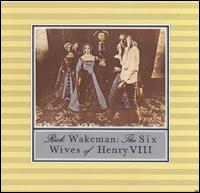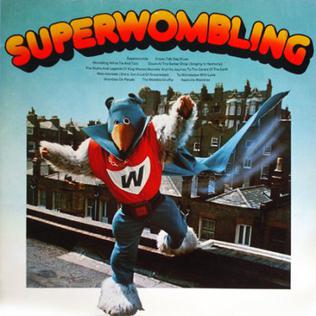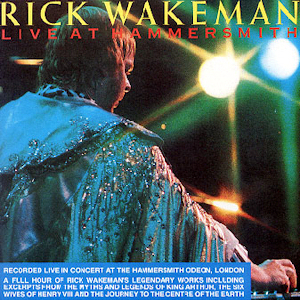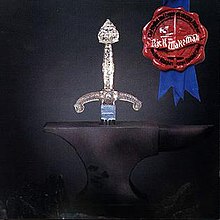
Yes are an English progressive rock band formed in London in 1968 by lead singer Jon Anderson, bassist Chris Squire, guitarist Peter Banks, keyboardist Tony Kaye, and drummer Bill Bruford. The band has undergone numerous lineup changes throughout their history, during which 20 musicians have been full-time members. Since February 2023, the band has consisted of guitarist Steve Howe, keyboardist Geoff Downes, bassist Billy Sherwood, singer Jon Davison, and drummer Jay Schellen. Yes have explored several musical styles over the years and are most notably regarded as progressive rock pioneers.

Richard Christopher Wakeman is an English keyboardist and composer best known as a former member of the progressive rock band Yes across five tenures between 1971 and 2004, and for his solo albums released in the 1970s. AllMusic describes Wakeman as a "classically trained keyboardist extraordinaire who plied his trade with Yes and developed his own brand of live spectacular in a solo act."

Tales from Topographic Oceans is the sixth studio album by English progressive rock band Yes, released on 7 December 1973 by Atlantic Records. It is their first studio album to feature drummer Alan White, who had replaced Bill Bruford the previous year. Frontman Jon Anderson devised its concept during the Close to the Edge Tour, when he read a footnote in Autobiography of a Yogi by Paramahansa Yogananda that describes four bodies of Hindu texts about a specific field of knowledge, collectively named shastras–śruti, smriti, puranas, and tantras. After pitching the idea to guitarist Steve Howe, the pair spent the rest of the tour developing an outline of the album's musical themes and lyrics.

Going for the One is the eighth studio album by English progressive rock band Yes, released on 15 July 1977 by Atlantic Records. After taking a break in activity in 1975 for each member to release a solo album, and their 1976 tour of the United States and Canada, the band relocated to Montreux, Switzerland to record their next studio album. During rehearsals, keyboardist Patrick Moraz left the group, which marked the return of Rick Wakeman who had left to pursue a solo career after differences surrounding Tales from Topographic Oceans (1973). In a departure from their previous albums, Going for the One, with the exception of the fifteen-minute "Awaken", features shorter and more direct songs without an overarching concept, and saw Yes record with new engineering personnel and cover artists.

Tormato is the ninth studio album by English progressive rock band Yes. It was released on 22 September 1978 on Atlantic Records, and is their last album with singer Jon Anderson and keyboardist Rick Wakeman before their departure from the group in 1980. After touring their previous album Going for the One (1977), the band entered rehearsals in London to record a follow-up. The album was affected by various problems, such as internal disputes over the direction of the music and artwork, and the departure of engineer Eddy Offord early into the sessions, resulting in the group producing the album themselves.

The Six Wives of Henry VIII is the first studio album by English keyboardist Rick Wakeman, released in January 1973 on A&M Records. It is an instrumental progressive rock album with its concept based on his interpretations of the musical characteristics of the wives of Henry VIII. After signing with A&M as a solo artist, Wakeman decided on the album's concept during a tour of the United States with the progressive rock band Yes. As he read a book about the subject on his travels, melodies he had written the previous year came to him and were noted down. The album was recorded throughout 1972 with musicians from Yes and The Strawbs, the group Wakeman was in prior to Yes, playing on the album.

Journey to the Centre of the Earth is the second album by English keyboardist Rick Wakeman, released on 3 May 1974 by A&M Records. It is a live recording of the second of his two concerts at the Royal Festival Hall on 18 January 1974, the premiere of his 40-minute orchestral rock piece based on Jules Verne's 1864 science fiction novel of the same name. It tells the story of Professor Lidinbrook, his nephew Axel, and their guide Hans, who follow a passage to the Earth's centre originally discovered by Arne Saknussemm, an Icelandic alchemist. Wakeman performs with the London Symphony Orchestra, the English Chamber Choir, and a group of hand-picked musicians for his rock band, which later became the English Rock Ensemble. Actor David Hemmings narrates the story.
Violinski was a rock band formed in 1977 by Electric Light Orchestra violinist Mik Kaminski with former member Mike de Albuquerque on guitar and vocals. In March 1979 the band become a one-hit wonder with their instrumental "Clog Dance", which made Number 17 the UK Singles Chart.

Hayley Sanderson is an English singer, songwriter and saxophonist. She is one of the vocalists on the BBC's Strictly Come Dancing and a musician on recordings by Rick Wakeman.

Fragile is the fourth studio album by the English progressive rock band Yes, released on 12 November 1971 by Atlantic Records. It was the band's first album to feature keyboardist Rick Wakeman, who replaced Tony Kaye after the group had finished touring their breakthrough record, The Yes Album (1971).

Lisztomania is the first soundtrack album by English keyboardist Rick Wakeman. It was released in November 1975 by A&M Records as the soundtrack for the Ken Russell's musical biographical film Lisztomania about the Hungarian composer Franz Liszt. Some tracks feature The Who's Roger Daltrey singing lead vocals.
Warhorse was a British rock band formed by Deep Purple's first bassist Nick Simper.
Anthony Ralph Clarke was an English rock music record producer and guitarist. Born in Coventry, he is best known for producing The Moody Blues from 1966 to 1978.

No Earthly Connection is a studio album by English keyboardist Rick Wakeman, released in April 1976 on A&M Records. After touring worldwide in late 1975 in support of his previous studio album The Myths and Legends of King Arthur and the Knights of the Round Table (1975), Wakeman retreated to Herouville, France to record a new studio album with his rock band, the English Rock Ensemble. He based its material on a part fictional and non-fictional autobiographical account of music that incorporates historical, futuristic, and science-fiction themes.

Superwombling was the fourth and final studio album released by the Wombles. The songs were recorded by Mike Batt (vocals/keyboards) with session musicians Chris Spedding (guitars), Les Hurdle (bass), Clem Cattini (drums), Ray Cooper (percussion), Rex Morris (sax), Eddie Mordue (sax) and Jack Rothstein (violin).

Rick Wakeman's Criminal Record is a studio album by English keyboardist Rick Wakeman, released on 9 November 1977 on A&M Records. After touring his previous album No Earthly Connection in August 1976, Wakeman rejoined the progressive rock band Yes as they recorded Going for the One (1977) in Switzerland. When recording finished, he started work on a new solo record which took form as a keyboard-oriented instrumental album similar to that of his earlier album, The Six Wives of Henry VIII (1973), and loosely based on criminality. Several guest musicians play on the record, including Chris Squire and Alan White of Yes, percussionist Frank Ricotti, and comedian Bill Oddie on vocals.

Classic Tracks is a progressive rock album of re-makes of classic Rick Wakeman songs. It features Wakeman and four American musicians.

Live at Hammersmith is the second live album by Rick Wakeman. Despite being a 1985 concert, the music performed is from the first three albums (1973–1975). During this show there was a power failure, and Wakeman walked to the front and told jokes for 45 minutes, although had to subsequently pay for running over time as the power had been restored after 3 minutes.

Piano Portraits is a studio album by English keyboardist Rick Wakeman, released on 13 January 2017 on Universal Music Group. The album was made following the positive reception to Wakeman's live radio performance of his piano arrangement of "Life on Mars?" by David Bowie following the singer's death in January 2016, and a subsequent single of the track released in aid of Macmillan Cancer Support released in 2016. After Wakeman received offers from several music labels to produce an album of piano arrangements, he chose Universal and chose songs that were his favourites: songs he had played on as a session musician, as a member of Yes, classical music pieces, and one original composition.

Gary Pickford-Hopkins was a Welsh singer, composer and guitarist whose career began in the early 1960s. He is best known as co-lead vocalist with Ashley Holt on two of Rick Wakeman's most successful solo albums Journey to the Centre of the Earth and The Myths and Legends of King Arthur and the Knights of the Round Table.



















